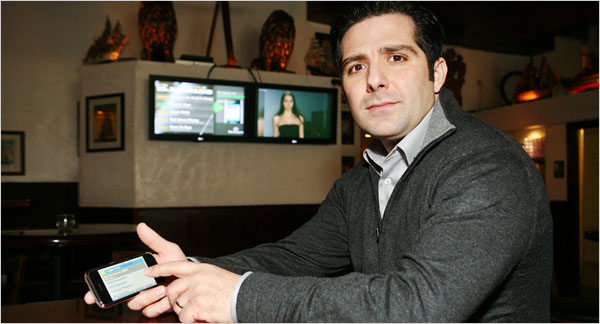
Akoo bridges digital and cell phone screens
February 25, 2008 by Dave Haynes
A little Chicago-area start-up is getting some big attention lately, particularly this past weekend with a credibility-boosting feature in the New York Times.
The paper was interested in how Akoo has developed an interactive relationship between mobile phones and digital screens, something Boston-based LocaModa has been doing for the last couple of years, but in different ways. And just recently, another Boston company, Aerva, launched an interactive bar app using mobile.
The story reports …

A LITTLE-KNOWN private company, Akoo International, is setting up a network of digital screens that can send and receive messages from cellphones. The company aims to transform mobile devices into universal remote controls that can select on-demand content from big-screen TVs in airports, bars and restaurants.
With Akoo’s network, named m-Venue, cellphone users can send a text-message request for a music video, sports clip or fashion show to be delivered to their phone or played on a nearby Akoo television screen, which would act much like a high-tech jukebox.
In return, companies can deliver digital coupons and promotions to the cellphones. For instance, a customer at a John Barleycorn restaurant in Chicago, part of the m-Venue network, might select a text message code displayed on a big screen — say, one that would deliver Gwen Stefani’s new music video.
The customer would then receive a text message to the effect of, “Thanks! Gwen Stefani will play shortly. Show this text to your server and get any appetizer for $1.”
VP Marketing Andy Stankiewicz had sent me a note a couple of weeks ago referencing a press release about the company, but it was one of those missives that had a lot more blah-blah-blah stuff than it hadinformation on how the thing worked. So I sent him that question …
At m-Venue, Stankewicz responded, we install our server loaded with location-specific content and a broadband connection for monitoring/uploading of new content at participating venues. We have licensing deals with Universal Music Group, Sony BMG, The Orchard, Fashion TV, sports clips, etc. (2+ million pieces of content and growing) – this content becomes available for patrons “on-demand” (within an allowable programming framework established with the location).
Patrons can queue up their selections, for public performance on the location’s A/V system, via text messaging (each piece of content has a code which is sent to a unique short code), mobile Internet or Wi-Fi.
We utilize a two-screen, “side-by-side” approach – one screen is dedicated to “on-demand” or default background programming, while the adjacent screen feature user tutorials, featured content, location-specific product merchandising, and third-party advertising, if appropriate for the venue.
Of course, our differentiation is the ability to provide location partners and marketers with consumer usage/behavioral data and metrics, as well as deliver permission-based ads, mobile coupons and marketing messages to the mobile phone in an integrated, contextual, and non-intrusive manner.
The NY Times story goes on to say:
Ad agencies have shown both interest in and trepidation about cellphone-activated digital signs. The creative agency Leo Burnett and its nontraditional sister shop, Arc Worldwide, both part of the Publicis Groupe, have signed an alliance with Akoo. The digital agency Avenue A/Razorfish, which is owned by Microsoft, is also discussing trials.
Texas State University became the first college to become part of Akoo’s network after Akoo made a deal with the food provider Chartwells, which manages food services for 200 American universities and is part of the Compass Group.
Akoo’s other public partners are mainly in the Chicago area, including the restaurant chain Bob Chinn’s Crabhouse; the Cubby Bear, a Chicago sports bar with live music; and Ala Carte Entertainment, the owner of several bars and restaurants in the area. Mr. Stankiewicz declined to say how many display screens were in the network.
What I find interesting, and smart, about Akoo’s approach is the use of a second-screen as a persistent tutorial piece. Possibly because I am just plain stupid, but more reflecting how I am somewhat less text-happy than my two teenaged kids, I have found some of the early SMS to screen things are hard to sort out — as in what string on numbers do I use, and where???
At least in the early days, if you can’t make new technology simple, make the how to use stuff obvious.
I’m in Chicago in a few weeks and now I have an excuse to go to a bar. Research!



[…] work on Chevron AV upgrade Humanscale’s eight-monitor mount is huge. Seriously. Akoo bridges digital and cell phone screens More evidence that the money is moving On the lighter side; “A lot of fellows nowadays […]